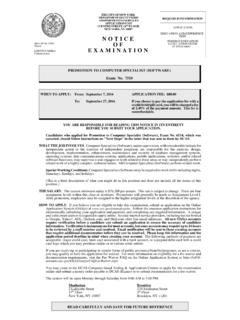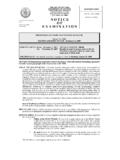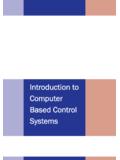Transcription of Communications-Computer Systems Programming - AF
1 DEPARTMENT OF THE AIR FORCE Headquarters US Air Force Washington, DC 20330-1030 CFETP 3D0X1 Parts I and II 1 September 2014 AFSC 3D0X1 KNOWLEDGE MANAGEMENT CAREER FIELD EDUCATION AND TRAINING PLAN ACCESSIBILITY: Publications and forms are available on the e-publishing Web site at for downloading or ordering. RELEASABILITY: There are no releasability restrictions on this publication. CAREER FIELD EDUCATION AND TRAINING PLAN KNOWLEDGE MANAGEMENT AFSC 3D0X1 Table of Contents PART I Abbreviations/Terms Explained ..5 Section A - General Information ..12 Purpose of the CFETP Usage Coordination and Approval of the CFETP Section B - Career Field Progression and Information ..14 Specialty Description and Key Positions Skill and Career Progression Training Decisions Community College of the Air Force Career Field Path Section C - Skill Level Training Requirements ..21 Purpose Specialty Qualification Requirements Section D - Resource Constraints.
2 23 Purpose Apprentice (3-Level) Training Journeyman (5-Level) Training Craftsman (7-Level) Training Superintendent (9-Level) Training Section E - Transition Training Guide ..23 2 PART II Section A - Specialty Training Standard ..24 Implementation Purpose Third-Party Certification Training Records for Senior NCOs Recommendations Section B - Course Objective List ..40 Measurement Standard Proficiency Level Section C - Support Materials ..40 List of Support Materials Section D - Training Course Index ..40 Purpose Air Force In-Residence Courses Air University/A4L Courses Exportable Courses Section E MAJCOM-Unique Requirements ..40 OPR: 336 TRS/TRR Certified by: CMSgt Robert Jackson, AF Career Field Manager (SAF/CIO A6CF) Supersedes: CFETP 3D0X1, dated 12 March 2012, w/Change 1 dated 1 July 2013 Pages: 40 3 CAREER FIELD EDUCATION AND TRAINING PLAN KNOWLEDGE MANAGEMENT SPECIALTY AFSC 3D0X1 PART I Preface 1. This Career Field Education and Training Plan (CFETP) is a comprehensive education and training document that identifies life-cycle education and training requirements, training support resources, and minimum core task requirements for this specialty.
3 The CFETP ensures individuals in this specialty receive effective and efficient training at appropriate points in their career. It provides a clear career path to success and instills rigor in all aspects of career field training. NOTE: Civilians and military filling associated positions may use Part II to support duty position qualification training. 2. IMPORTANT: This CFETP is not a stand-alone document. It must be used in conjunction with the 3 DXXX Cyberspace Support (Common Core) CFETP, which outlines tasks and courses shared by other 3D specialties. Together, the 3 DXXX and 3D0X1 CFETPs provide comprehensive career field guidance and training for members of the AFSC 3D0X1. 3. The CFETP consists of two parts. Supervisors plan, manage, and control training within the specialty using both parts of the plan. Part I provides information necessary for overall management of the specialty. Section A explains how to use the plan. Section B identifies career field progression information, duties and responsibilities, training strategies, and career field path.
4 Section C associates each level with specialty qualifications (knowledge, education, experience, training, and other). Section D indicates resource constraints ( funds, manpower, equipment, facilities). Section E identifies transition training plans for the 3D0X1 career field. Part II includes specific training standards and resources. Section A identifies the Specialty Training Standard (STS) and includes duties, tasks, and technical references to support training. Air Education and Training Command (AETC) conducts training, core task and correspondence course requirements. Section B lists course standards and proficiency levels. Section C identifies available support materials. Section D identifies a training course index supervisors can use to determine resources available to support training, including both mandatory and optional courses. Section E identifies Major Command (MAJCOM) unique training requirements to determine additional training required for the associated qualification needs.
5 Supervisors and trainers will use Part II to identify, plan, and conduct training commensurate with the overall goals of this plan. 4. Use of the guidance provided in this CFETP provides the foundation for effective and efficient training for individuals in this career field at the appropriate points in their careers. This plan enables the Air Force to train today's workforce for tomorrow's jobs. 4 Abbreviations/Terms Explained This section provides a common understanding of the terms that apply to the Knowledge Management Career Field and Education Training Plan. Advanced Training (AT). A formal course of training that leads to a technical or supervisory level of an AFS. Training is for selected Airmen at the advanced level of an AFS. Air Education Training Command (AETC). Responsible for the recruiting, training and education of Air Force personnel. AETC also provides pre-commissioning, professional military and continuing education. Air Force Career Field Manager (AFCFM).
6 Representative appointed by the respective HQ USAF Deputy Chief of Staff or Under Secretariat to ensure that assigned Air Force specialties are trained and utilized to support Air Force mission requirements. Air Force Enlisted Classification Directory (AFECD). The official directory for all military enlisted classification descriptions, codes, and identifiers establishes the occupational structure of the Air Force enlisted force. The occupational structure is flexible to permit enlisted personnel to specialize and develop their skills and abilities while allowing the Air Force to meet changing mission requirements. Individual enlisted personnel have a joint responsibility with commanders and supervisors at all levels to fully develop their abilities consistent with Air Force needs and within the established patterns of specialization. Air Force Job Qualification Standard (AFJQS). A comprehensive task list that describes a particular job type or duty position.
7 Supervisors use the AFJQS to document task qualification. The tasks on AFJQSs are common to all persons serving in the described duty position. Air Force Qualification Training Package (AFQTP). An instructional course designed for use at the unit to qualify or aid qualification in a duty position, program, or on a piece of equipment. It may be printed, computer -based, or other audiovisual media. Air Force Specialty (AFS). A group of positions (with the same title and code) that require common qualifications. Air University Associate-to-Baccalaureate Cooperative (AU ABC). Allows Airmen to turn a Community College of the Air Force Associates Degree into a Bachelor s Degree from an accredited university. The ABC program has established a partnership with various civilian higher-education institutions to offer four-year degree opportunities via distance learning. The participating schools will accept all of the credits earned by Airmen who have attained a CCAF degree and apply them to a Bachelor s degree related to their Air Force specialty.
8 Career Field Education and Training Plan (CFETP). A CFETP is a comprehensive core training document that identifies: life-cycle education and training requirements, training support resources, and minimum core task requirements for a specialty. The CFETP aims to give personnel a clear path and instill a sense of industry in career field training. CFETPs are officially posted at Certification. A formal indication of an individual s ability to perform a task to required standards. Certifying Official. A person assigned by the commander to determine an individual s ability to perform a task to required standards. 5 Chief Enlisted Manager (CEM) Code. A code use to identify all chief master sergeant positions in the Enlisted Classification Structure. They also identify chief master sergeants who, through extensive experience and training, have demonstrated managerial ability to plan, direct, coordinate, implement, and control a wide range of work activity.
9 Some managerial duties and responsibilities that are common to all chief enlisted managers are: managing and directing personnel resource activities; interpreting and enforcing policy and applicable directives; establishing control procedures to meet work goals and standards; recommending or initiating actions to improve functional operation efficiency; planning and Programming work commitments and schedules; developing plans regarding facilities, supplies, and equipment procurement and maintenance. Cloud Computing. The use of computing resources (hardware and software) that are delivered as a service over a network (typically the Internet). Collaboration. Collaboration is the interaction among two or more individuals encompassing a variety of behaviors, including communication , information sharing, coordination, cooperation, problem-solving and negotiation. Collaborative Tools. Collaborative tools consist of various web-based technologies including advanced white boarding, groupware, and facilitation.
10 Collaborative capabilities assist significantly with managing information throughout its life cycle and enable Air Force members to perform most office-oriented and operational communication tasks from their desktops. computer Based Training (CBT). A training method in which students learn through a computer terminal or similar device; emphasizes effective and efficient delivery of training objectives by allowing students to train from virtually any location and control the pace and length of training. Content Management. A set of processes and technologies supporting the evolutionary life cycle of digital information. This digital information is often referred to as content or, to be precise, digital content. Digital content may take the form of text, such as documents, multimedia files, such as audio or video files, or any other file type that follows a content life cycle that requires management. Continuation Training. Additional advanced training that exceeds the minimum upgrade training requirements and emphasizes present or future duty assignments.
















